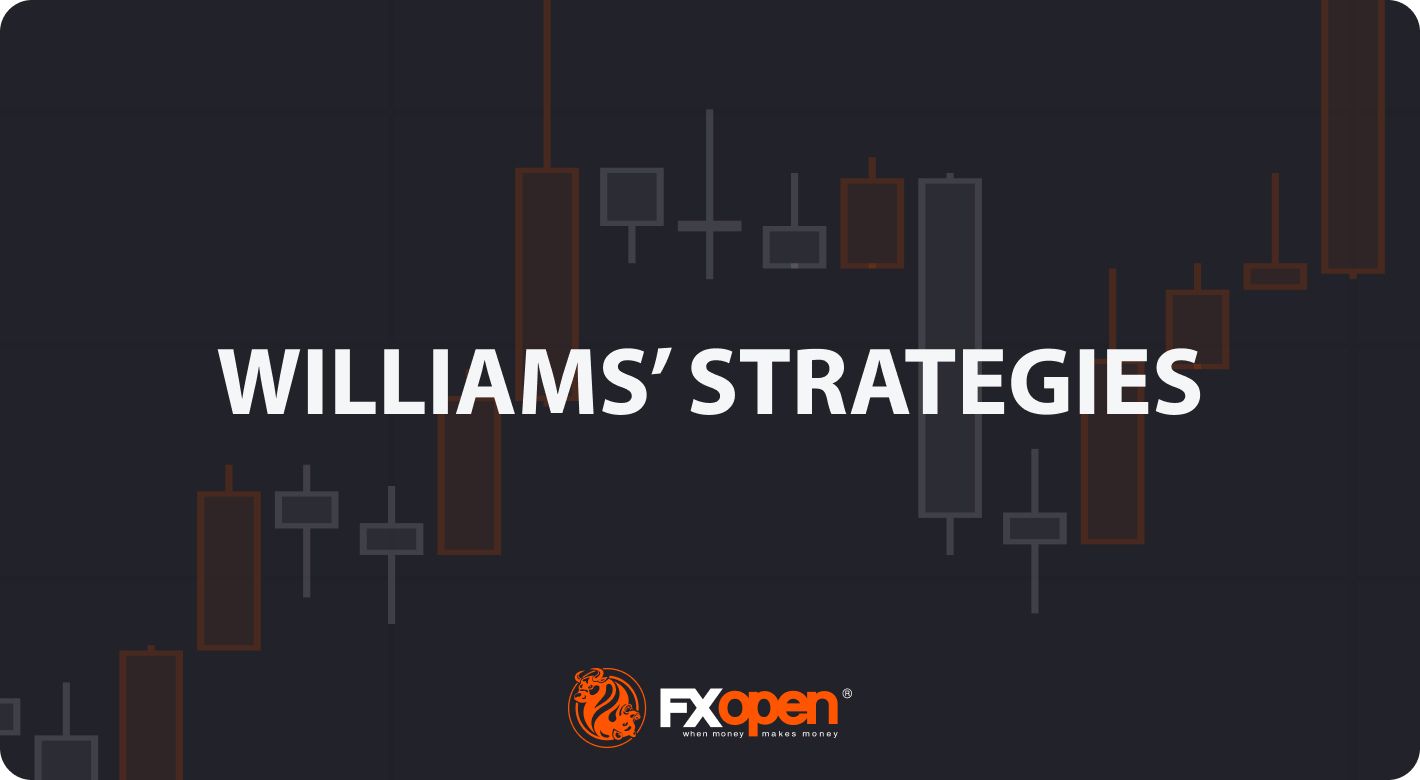FXOpen

In trading, Williams’ indicators stand out for their distinct approach to market analysis. Employed in many successful traders’ strategies, they can provide unique insights that help traders navigate the market with confidence. This article explores two key Williams’ strategies and provides insights into their applications, benefits, and potential challenges in the contemporary trading landscape.
Indicators of Bill Williams and Larry Williams
Bill Williams and Larry Williams are renowned traders and authors who have significantly contributed to the field of technical analysis. Larry Williams is well known for various technical indicators used in momentum and reversal trading, like the Williams %R and Ultimate Oscillator.
Bill Williams, meanwhile, focused on trading psychology and the application of chaos theory in trading. He created several well-known indicators, like the Williams Fractals, Alligator, and Awesome Oscillator.
Both sets of indicators have become staples in traders' toolkits, often used in conjunction with other analysis tools to provide a holistic view of the market. Their contributions have left a lasting impact, shaping the trading strategies of many professionals in the trading world.
You’ll find each of Williams’ indicators available on FXOpen’s free TickTrader platform. Head over there to follow along with the strategies below.
Williams Fractals + Alligator Strategy
This strategy combines two distinct indicators: the Williams Fractals and the Alligator. Here's how they work and how they can be applied in forex day trading strategies:
- Williams Fractal: This indicator identifies local price extremes and potential reversal points in the market. Set to its default.
- Alligator Indicator: Comprising three smoothed moving averages, called Lips (green), Teeth (red), and Jaw (blue). They are set to their defaults here.
Entry Rules
Buy Opportunity:
- Traders can look for the Lips to cross above the Teeth and Jaw (Alligator opening its mouth), indicating a potential bullish trend.
- If an UP Fractal appears after this cross is broken (i.e., resistance is broken), traders may enter after the close of the break.
Sell Opportunity:
- Traders can look for the Lips to cross below the Teeth and Jaw (Alligator closing its mouth), indicating a potential bearish trend.
- If a DOWN Fractal appears after this cross is broken (i.e., support is broken), traders often enter after the close of the break, initiating a sell position.
Exit Rules
Buy Exit:
- Traders might choose to exit when the Lips cross below the Teeth and Jaw, indicating the potential end of the bullish trend.
Sell Exit:
- Exiting may occur when the Lips cross above the Teeth and Jaw, signalling the potential end of the bearish trend.
Stop Loss:
- A stop loss can be placed at a nearby swing point or opposing Williams fractal (a DOWN fractal for a buy, UP fractal for a sell).
Williams %R + Moving Average Strategy
This strategy fuses two crucial elements: the Williams %R indicator and a 13-period Exponential Moving Average (EMA). Here's a detailed breakdown of how they work together and can be applied:
- Williams %R: This oscillator indicates overbought (OB) or oversold (OS) conditions in a market. Traders often look for the %R to be OB (above -20) or OS (below -80).
- 13-period Exponential Moving Average (EMA): This moving average emphasises recent prices and is used to detect short-term trends.
Entry Rules
Buy Opportunity:
- Traders may look for the %R to cross above -80, signalling a bullish shift.
- If the price then convincingly closes above the 13-period EMA, this may be a cue to buy.
Sell Opportunity:
- Traders can wait for the %R to cross below -20, indicating a potential bearish trend.
- If the price firmly closes below the 13-period EMA, it might be time to sell.
Exit Rules
- Profits could be taken when %R moves from one extreme to the other (OB to OS or vice versa) or at another predetermined level, such as support or resistance points if desired.
Stop Loss:
- A stop loss might be placed above or below a nearby swing point.
Pros and Cons of Williams' Strategies/Indicators
While Williams' indicators have become a valuable addition to many traders' toolkits, they come with their own sets of advantages and disadvantages.
Pros:
- Versatility: These indicators can be applied to different markets and time frames.
- Trend Identification: They help in recognising prevailing market trends and potential reversals, aiding in timely entries and exits.
- Complement to Other Tools: Often used in tandem with other indicators, they enhance a trader's ability to interpret market conditions.
Cons:
- False Signals: Williams' indicators may generate false signals, especially in a sideways market, leading to potential losses.
- Complexity for Traders with Zero Experience: Though powerful, they can be complex and require a solid understanding of their functions and settings.
- Dependency on Settings: Sensitivity to market changes can vary with settings, demanding potential adjustments and fine-tuning.
The Bottom Line
In essence, Williams' indicators and strategies can offer traders valuable insights into the market’s potential direction. Moreover, they can be used not only as forex but as stock market trading strategies. Whether utilising Fractals, Alligator, or %R, careful application can enhance your trading results. If you're interested in applying these strategies to your trading, you can open an FXOpen account to access these indicators, low-cost trading fees, and rapid executions. Good luck!
This article represents the opinion of the Companies operating under the FXOpen brand only. It is not to be construed as an offer, solicitation, or recommendation with respect to products and services provided by the Companies operating under the FXOpen brand, nor is it to be considered financial advice.
Stay ahead of the market!
Subscribe now to our mailing list and receive the latest market news and insights delivered directly to your inbox.








